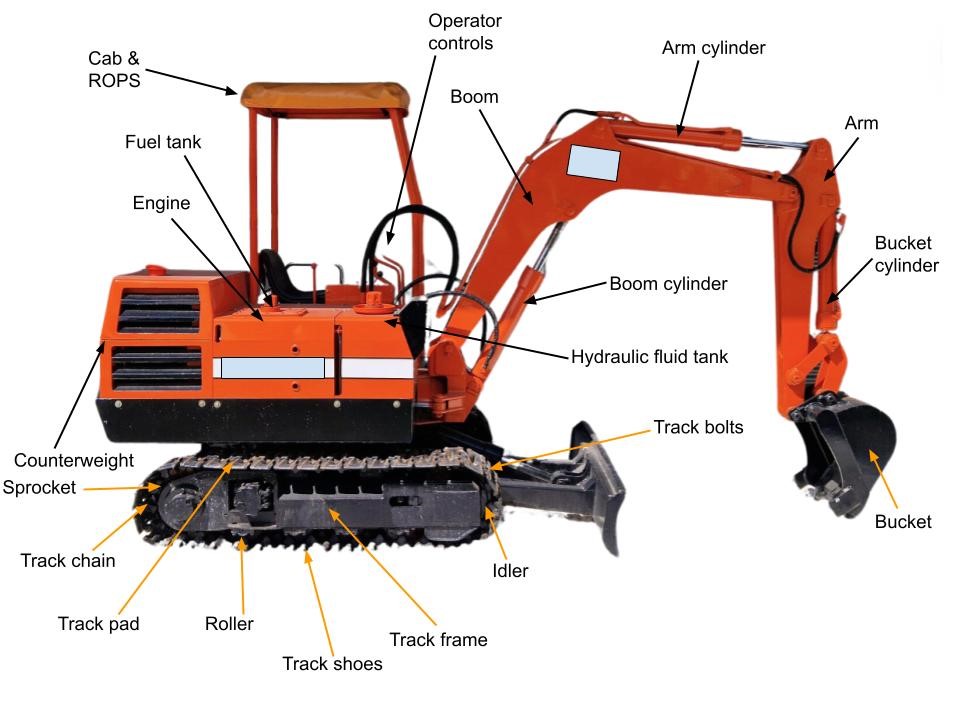While it’s true that mini excavators are small machines, their capabilities are nothing short of impressive. And if you’re a homeowner who loves to do DIY projects, there’s a good chance that you’ve rented a small excavator to help you with tasks in landscaping projects, pool installation, or any number of other projects.
But do you know all the parts of a mini excavator? Even if your mini excavator rental spans just one day, it’s best practice to familiarize yourself with the equipment’s makeup.
This is your handy guide to recognizing and understanding the different parts of a mini excavator.
The 3 Key Mini Excavator Part Groups
A mini excavator’s parts are often classified into three distinct groups:
- The undercarriage
- The cab
- The arm and boom
Let’s take a closer look at each of these groups.
1. The Undercarriage
Equipment undercarriage refers to the underlying framework that supports the machine. In this case, the undercarriage supports the mini excavator.
Here are the parts associated with a mini excavator’s undercarriage.
Tracks
Instead of wheels, most mini excavators move around on tracks. It’s important to note that the term track is often used interchangeably with track frame.
Track Frame
The mini excavator tracks attach to the track frame providing support for the tracks. The track frame is attached to the mini excavator’s undercarriage.
The tracks and track frame enable the mini excavator’s total weight to spread out evenly. In turn, this reduces the mini excavator’s pressure on the ground—hence their popularity for indoor and residential projects.
Track Pads
A track frame component, track pads are what touches the ground. They help provide traction and stability while reducing vibration, damage, and noise levels.
Track Chains
Track chains help anchor the trackpads to the frame and support the mini excavator’s movement.
Track Shoes
Track shoes are the parts of the track that jut out and dig into the ground to help move the mini excavator.
Track Bolts
Track bolts help hold the various parts of the track frame together.
Rock Guards
Rock guards protect the mini excavator’s undercarriage from rocks and debris.
Sprockets
Sprockets connect with the links of the track chain to ensure the chain properly aligns with the undercarriage. Sprockets also help propel the mini excavator’s movement.
Rollers
Rollers are metal cylinders that help support the mini excavator’s weight and guide the track chains along the track frame via a continuous rolling surface.
Idlers
Idlers guide the tracks and maintain the track’s alignment with the mini excavator’s undercarriage.
2. The Cab
Often referred to as mission control or the control center, the cab houses several important parts of a mini excavator and is also where the operator works.
Operator Controls
Operator controls vary from one mini excavator to another, but they ultimately encompass the various controls that execute actions and activities.
ROPS (Rollover Protection Structure)
The rollover protection structure, or ROPS, is the frame that surrounds the cab and serves to protect the operator if the mini excavator were to tip and roll over.
Counterweight
The counterweight is at the back of the mini excavator, and it prevents the machine from tipping by counterbalancing its weight during operation.
Engine
The engine is where the mini excavator gets its power. The engine is usually located near the cab to promote easy access.
Hydraulic Fluid Tanks
Hydraulic fluid tanks hold the fluid that powers much of a mini excavator’s movements and mechanisms.
Fuel Tank
The fuel tank is located within the cab and holds diesel fuel to power the mini excavator’s engine.
Main Control Valve
The main control valve, which is located within the cab, helps regulate the flow of hydraulic fluid to the mini excavator’s various hydraulic mechanisms, controlling their movement accordingly.
3. The Arm and Boom
The arm and boom is the part of the mini excavator you probably think of first, especially since this is where most of the operational action is visible.
Boom
The boom is attached to the mini excavator’s cab and holds the arm; it’s the first part you can see extending from the machine.
Arm
Often referred to as the stick or dipper, the arm attaches the mini excavator boom to the bucket.
Bucket
The bucket is connected to the end of the mini excavator’s arm.
Boom Cylinder
The boom cylinder controls the boom’s movement via extension and retraction.
Arm Cylinder
The arm cylinder controls the arm’s motion via extension and retraction.
Bucket Cylinder
The bucket cylinder controls the bucket’s movement by opening and closing its jaws.
Attachments
Some mini excavator attachments, like grapples or augers, replace the bucket. Others, like thumbs and rakes, attach directly to the mini excavator’s bucket or the quick coupler system.
Are There Any Mini Excavator Rentals Near Me in Naples, Florida?
Equipment Source offers seven locations, and we are ready to help you access the tools and equipment you need to finish your projects. If you’re asking yourself, Are there any small equipment rentals near me?, you can rest assured that The Equipment Source has you covered. From questions about our equipment rental availability to dropping off tools and equipment at your work site, our experienced team is here to help you get your project done.
If you have questions or are ready to rent, contact our equipment rental experts today!

